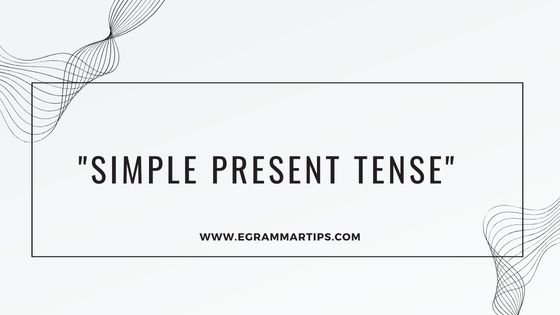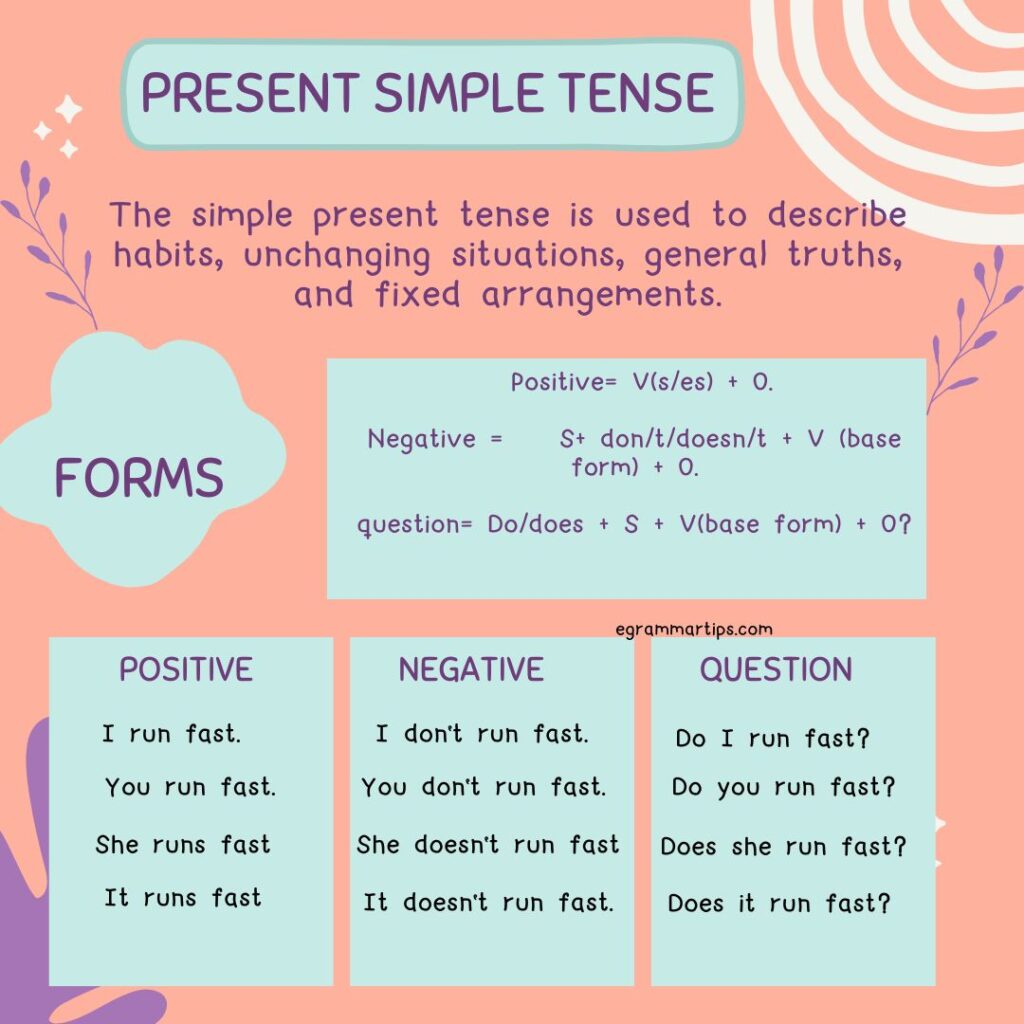

The Present Simple Tense is one of the most fundamental and widely used tenses in English. It’s primarily used to describe habitual actions, general truths, and situations that are always true. Here’s a detailed explanation:
a. Affirmative Sentences:
For most verbs:
Subject + base form of the verb.
Example: I walk to school every day.
For third-person singular (he, she, it):
Subject + base form of the verb + “-s” or “-es.”
Example: She walks to school every day.
b. Negative Sentences:
For all subjects:
Subject + “do/does not” + base form of the verb.
Example: I do not (don’t) walk to school every day.
Example: He does not (doesn’t) walk to school every day.
c. Interrogative Sentences:
For all subjects:
“Do/Does” + subject + base form of the verb?
Example: Do you walk to school every day?
Example: Does she walk to school every day?
2. Uses of the Present Simple Tense
a. Habitual Actions:
The present simple is often used to describe habits or actions that happen regularly.
Example: I go to the gym every Monday.
b. General Truths and Facts:
It’s used to state facts or general truths that are always true.
Example: Water boils at 100 degrees Celsius.
c. Permanent Situations:
The present simple is used for situations that are seen as permanent or long-lasting.
Example: He lives in New York.
d. Scheduled Events (especially in the near future):
It can be used to describe future events that are scheduled or part of a timetable.
Example: The train leaves at 6 PM.
e. Instructions and Directions:
Present simple is used when giving instructions or directions.
Example: You take the first left and then go straight.
f. With Stative Verbs:
Stative verbs describe a state rather than an action (e.g., know, like, seem). These verbs are typically used in the present simple rather than the present continuous.
3. Spelling Rules for the Third-Person Singular
•When using the present simple tense with he, she, or it, the verb usually ends with an “-s” or “-es.”
Here are the rules:
•Add “-s” to most verbs:
Example: He runs every morning.
•Add “-es” to verbs that end in “-ch,” “-sh,” “-x,” “-s,” “-ss,” “-z,” or “-o”:
Example: She watches TV in the evening.
•For verbs ending in a consonant + “-y,” change “-y” to “-ies”:
Example: He studies hard for his exams.
•For verbs ending in a vowel + “-y,” just add “-s”:
Example: She plays tennis every weekend.
4. Common Mistakes with Present Simple Tense
•Omitting the ‘-s’ in third-person singular:
Incorrect: She walk to school every day.
Correct: She walks to school every day.
•Using “do” instead of “does” for third-person singular in questions:
Incorrect: Do she like pizza?
Correct: Does she like pizza?
•Using the present continuous tense when the present simple is needed:
Incorrect: I am knowing the answer.
Correct: I know the answer.
5. Time Expressions Often Used with Present Simple
To indicate the frequency of the actions or to emphasize the regularity, the present simple is often used with specific time expressions:
Adverbs of frequency: always, usually, often, sometimes, rarely, never.
Example: He always arrives on time.
Expressions like: every day, every week, once a month, twice a year, etc.
Example: I visit my grandparents every summer.
6. Present Simple vs. Present Continuous
The present simple is often contrasted with the present continuous tense, which is used to describe actions happening right now or temporary actions. Understanding the difference is crucial:
Present Simple: I work at a bank. (This is a permanent situation.)
Present Continuous: I am working on a project right now. (This is a temporary situation.)
7. Exercises to Practice Present Simple
Fill in the blanks:
She ______ (go) to the gym every day.
They ______ (not, like) spicy food.
______ (you, read) the newspaper daily?
Answers:goes
do not like (don’t like)
Do you read
Conclusion
The present simple tense is essential for communicating daily routines, facts, and general truths. Mastering this tense provides a strong foundation for understanding and using other English tenses effectively.